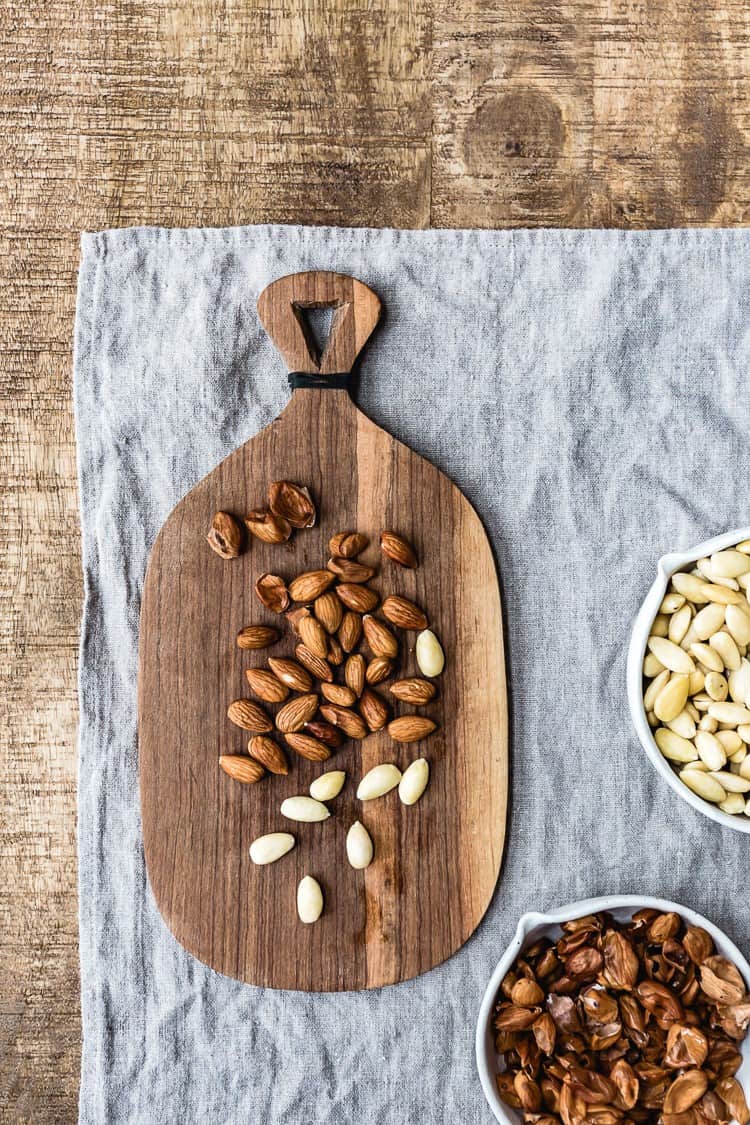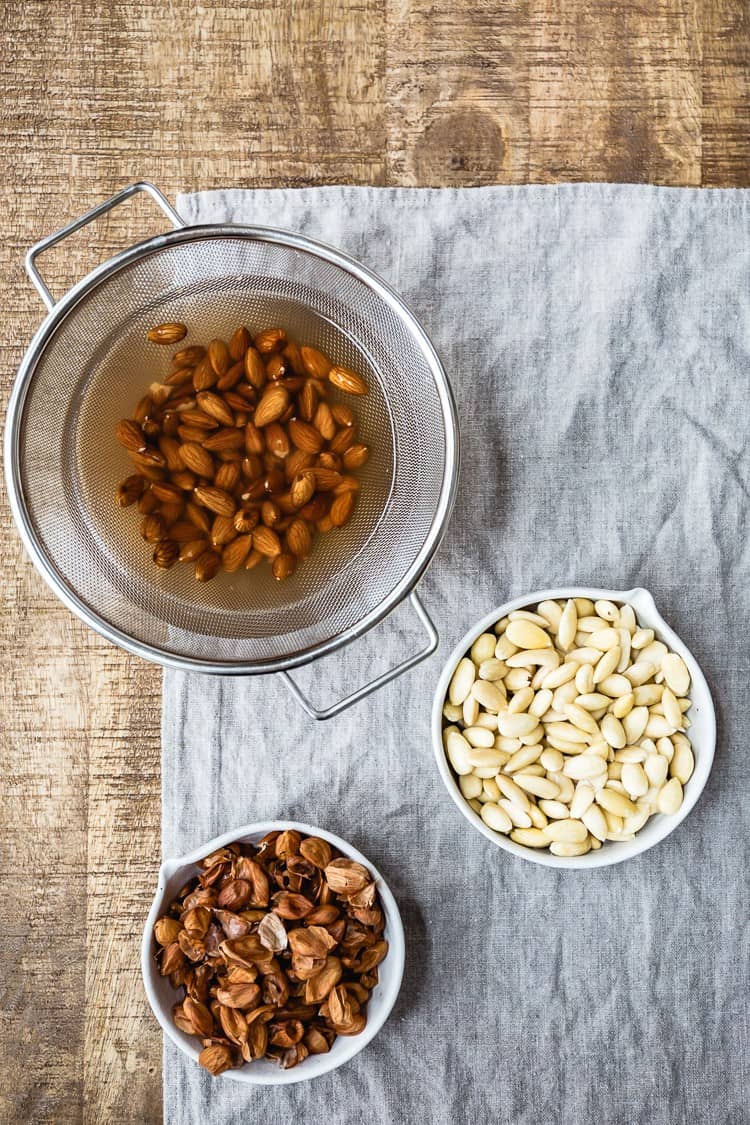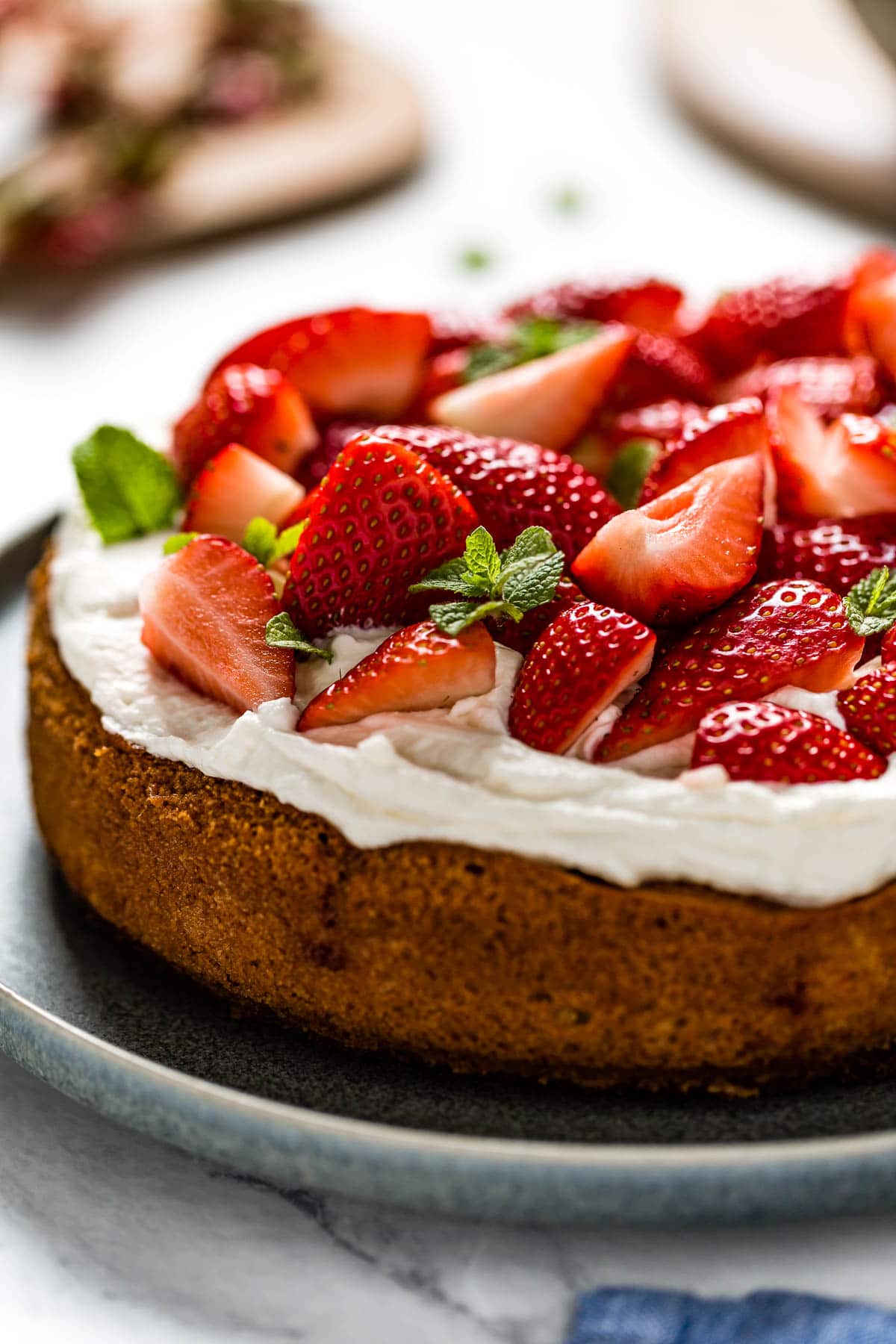If you have been around for a while, you know that I love using almond flour in my baking. Over the years, I have published several almond flour recipes and have gotten a great response from my readers.
With that being said, several readers reached out to let me know that they find almond flour to be too expensive to use it on a regular basis. I can certainly relate because before a recipe goes onto the blog it gets tested at least 3 times. This means using the same ingredients 3 times. And this does not include the version I made to photograph the recipe for the blog post. As you can imagine, it adds up resulting in big grocery expenses every month.

Table of Contents
- What Are Blanched Almonds
- How To Blanch Almonds
- How To Peel?
- How To Dry?
- How To Store Skinless Almonds? & How Long Do They Last?
- Are Blanched Almonds Healthier?
- What To Do With The Almond Skins (aka Almond Peel)
- How To Roast?
- The Uses of Blanched Almonds
- Other Recipes To Using Skinless Almonds:
- Where To Buy Blanched Almonds
- How to Blanched Almonds – Blanched Almonds Recipe
So I decided to take the matters into my own hands and find a way to make almond flour at home cheap. Or I should say, cheaper than what it is sold for at the supermarkets. I am happy to tell you that I was able to succeed in using two different methods. However, before we start talking about how to make almond flour, we need to talk about how to blanch almonds.

While you can make almond flour using almonds with skin on (that version is called almond meal), most almond flour sold at the supermarkets are made with blanched almond flours. One of the reasons why it is expensive is for the labor that goes to the blanching process. The good news is that with just a little planning and time you can easily blanch your own almonds.
Here is a comprehensive guide with all your questions answered on how to blanch almonds at home, what they are, and different methods on blanching them:
What Are Blanched Almonds
Blanched almonds mean almonds without skins. Some markets sell and call them as “skinless almonds.” Here, blanching means removing the skins from the almond.

How To Blanch Almonds
When it comes to blanchings almonds you have 2 options:
Overnight Soaking Method
You can soak raw almonds (with the skin on) in a cup filled with cold water.
To do so, simply place almonds in a bowl and fill it with cold tap water until they are fully covered. Cover the bowl loosely with plastic wrap or a paper towel and let is sit overnight.
In the morning, drain almonds using a colander and gently squeeze the almonds to loosen their skin. It should come off easily.
Boiling Method
Alternatively, you can fill a small saucepan with 2 cups of water and bring it to a boil. Once it comes to a boil, you can place the almonds into the saucepan and let them sit in there for 2 minutes.
Drain using a colander, rinse under cold water and start peeling off immediately. Here there are 2 important things:
- Be sure to keep an eye on the almonds as if you let them sit longer they will start softening too much. You should drain them as soon as you see their skins start looking wrinkled. In my experiments, I found out that this happens between 1 or 2 minutes.
Once you drain and rinse them, you need to start peeling the skins while they are still warm because as they sit in room temperature (and cool down) it becomes harder to remove the skins. - Depending on what recipe you plan on using them, it is important to make sure to dry them completely. This step is crucial especially if you are using blanched almonds to make almond flour at home.
How To Peel?
After they are soaked or boiled, the almonds will be slightly softer. To remove skins from almonds, gently squeeze between your index finger and thumb. It should easily slide off.
How To Dry?
To dry, line a sheet pan with a few sheets of paper towels, scatter the freshly blanched almonds on it, and let them dry for 4-6 hours or even overnight.
With that being said, I do not recommend letting them sit longer (than overnight) as they will start losing their freshness.

How To Store Skinless Almonds? & How Long Do They Last?
The best way to store blanched almonds is to place them in a jar with a tight-fitting lid and keep them in a dark, cool, and dry place. This way they will be fresh up to a month.
Alternatively, you can store them in an airtight container in the fridge for up to 3 months or in the freezer for up to a year.
Are Blanched Almonds Healthier?
The following is from Healthline:
The powerful antioxidants and Vitamin E in almonds are largely concentrated in the brown layer of the skin. For this reason, blanched almonds — those with skin removed — are not the best choice from a health perspective.
Healthline: Benefits Of Almonds
What To Do With The Almond Skins (aka Almond Peel)
It is no secret that as you peel almonds you will be left with a lot of skins. I used to throw them away, but after learning that the outer layer is where all the goodness is at I no longer do that.
Instead, I dry them on a sheet pan, process them in a food processor to later add in my smoothies or oatmeal in the morning.

How To Roast?
If you are a fan of roasting almonds, you can easily roast whole blanched almonds. To do so simply:
- Preheat the oven to 350 F degrees.
- Place skinned and fully dried almonds on a small sheet pan.
- Roast 10-15 minutes checking and turning them every 5 minutes.
The Uses of Blanched Almonds
While I am publishing this how to blanch almonds post in preparation to show you how to make almond flour at home, there are many other uses of blanched almond flours. Most people use to make almond milk or almond flour to use both in savory recipes and in gluten-free baking.
A good example of where I use blanched almonds is this Braised Chicken Thighs with Mushrooms and Almond Puree dish. In this recipe, I pureed blanched almonds in my food processor to use as a thickener for the sauce. Though I published this recipe back in 2015, I make it often in my kitchen and love the nutty flavors that the almonds give to the overall dish.
Other Recipes To Using Skinless Almonds:
Here are a few simple ideas to put them to good use:
- Top off your steel-cut oatmeal with a handful of them.
- Use them in granola recipes as I did in my chunky granola recipe.
- Place them in a food processor or high-powered blender (such as Vitamix) and make almond flour at home and use it to make Almond Flour Banana Bread, Almond Flour Bread, or Almond Flour Cookies.
FUN TIP: You might be wondering what is the difference between blanched almonds vs raw almonds. The difference (if that) is in the terminology.
A raw almond could be with or without the skin (aka blanched).
Where To Buy Blanched Almonds

If the additional cost is not an issue for you, you can always get blanched almonds at your supermarket. I usually order it on amazon have used this brand (affiliate link) to be a good one.

How to Blanch Almonds – Blanched Almonds Recipe
Ingredients
- 1 cup raw almonds, they should not be salted or roasted
- 2 cups water – cold tap water is fine
Instructions
Method 1 – Overnight Method:
- Place almonds in a small cup and fill with water.
- Let is sit overnight.
- In the morning drain using a colander and rinse with cold water.
- Gently squeeze each almond to remove its skin.
- Place blanched almonds on a sheet pan lined with paper towels to dry.
Method 2 – Boiling Water Method:
- Bring water to boil in a small saucepan.
- Once it comes to a boil, add in the almonds and let them sit in there for 1-2 minutes or until the skins start getting wrinkly.
- Drain and rinse with cold tap water.
- Gently squeeze each almond to remove its skin.
- Place blanched almonds on a sheet pan lined with paper towels to dry.
Notes
- The nutritional value below is for 1 cup of blanched almonds
-
If you are a fan of roasting almonds, you can easily roast whole blanched almonds. To do so simply:
- Preheat the oven to 350 F degrees.
- Place skinned and fully dried almonds on a small sheet pan.
- Roast 10-15 minutes, checking and turning them every 5 minutes, until they turn lightly golden. Let them cool before serving.
Nutrition
Nutrition information is automatically calculated, so should only be used as an approximation.
This post was published in May 2018. It has been updated with additional helpful information with no changes to the originally published recipe in May 2020.














Is it possible/recommended to use blanched almonds that have been roasted to dry them out in making almond flour? Or is it better to let the blanched almonds dry overnight and run them through the blender without roasting to get a good flour?
Hello Denis,
I think they would both work, but I would make sure that they are fully dried. Moisture will turn it to almond butter so just make sure that they are fully dried before processing them.
Hope this helps.
I have been soaking almonds and blanching for years and love them. I do this to get the phytates off of them so they are easier to digest. I just found out that they also have lectins on them and soaking them takes the lectins off also. I usually soak them overnight and had no idea I could boil them. My question is does boiling them get rid of the phytates and lectins the same as if soaking them overnight even if I leave the skins on? Also after I soak them I put them in my dehydrator for about 30 to 34 hours. They are so good. I give them as gifts to many people who tell me that they have never had almonds taste so good. I
usually keep my almonds in the fridge to keep them fresh. Thank you for all your good recipes, tips and ideas.
Hello Roberta,
I love your tip about putting them in a dehydrator. I do not have one but I have always wanted to get it so this might be a good excuse.:)
To be honest, I am not 100% sure but I think boiling has a similar effect. I don’t boil them for too long but you can certainly boil them longer should you wish to do so.
Hope this helps.
Costco has a great deal on raw almonds and I am always looking for ways to use up the 3# bags. I eat a handful for breakfast and roast some for salads but start to get anxious that they lose freshness if I don’t freeze them or use faster.
Good point. Thanks for sharing Ann.
Hi just bought roasted almond with skin as you said It can’t be blanch when it is roated can I still use it as an almond butter instead of peanut? Can I made almond flour out of roasted almond with skin?
Hi Mirasol,
Here are my answers to your questions:
– Can I still use it as an almond butter instead of peanut? You absolutely can use it to make almond butter. Simply put roasted almonds in a food processor and process until it turns into almond butter.
– Can I made almond flour out of roasted almond with skin? You can. However, if you decide to use it in baking, your baked goods will have a strong roasted flavor. In some recipes this might be a good thing, while in others you may feel like the roasted flavor has taken over. For example, if you are making a almond flour chocolate cake, the flavor of cacao is strong enough to compliment the roasted flavors. Whereas, if you are making it to make an Almond Flour Apple Cake, it may take over the whole cake.
With all this being said, I think it is a personal preference. I urge you to give it a try and see what works for your taste buds.
I hope I answered your question. If not, I am always here to help. Feel free to send your questions my way.
Cheers,
Ice
I’m using always the 1st method, but I tried the 2nd one also. It’s so easy and usable. Thanks for the instructions
You bet. So glad to hear that you have been using these techniques Darly. Thanks for coming by and sharing your experience.